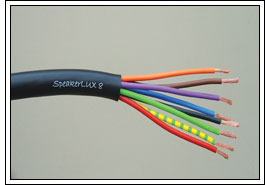 — Manas Kundu, Associate Director-Energy Solutions,
International Copper Promotion Council IndiaInternational Copper Promotion Council India
— Manas Kundu, Associate Director-Energy Solutions,
International Copper Promotion Council IndiaInternational Copper Promotion Council India (ICPCI), formed in
2001, is the Indian centre of the International Copper Association
(ICA) the leading organisation for the promotion of copper
worldwide. ICA operates in 24 countries through 31 centres. ICPCI
actively promotes copper through seminars, workshops and
training programmes all over India.
Manas Kundu discusses the
role of copper, the indispensable material for wiring, in light of
India's power sector ambitions. Kundu explains how ICPCI is doing
its bit in creating awareness about safe practices in electrical
wiring. An interview by
Venugopal Pillai.
Tell us in brief about the demand-supply scenario of copper,
especially in view of the sharply rising demand from the power
sector.
According to International Copper Study Group global copper
mine production in 2011 reached over 16 million tonnes. During
the same year, smelter production reached over 15.8 million
tonnes and refinery production increased to 19.5 million
tonnes.
Refined copper usage (usage by semis plants or the first
users of copper) in 2011 reached nearly 20.1 million tonnes.
China was also the largest consumer of refined copper in 2011
with apparent usage of over 7.9 million tonnes, according to
World Copper Factbook 2012 published by ICSG.
Considering Indian market the demand is apparently
estimated around 1 million tonnes, lion's share of which is met
by smelters and refiners located here. India does not figure in
top 20 countries in copper mining but in copper smelter
production it comes in top five countries, China being topmost.
Similarly in refined copper, production India comes within top
10 countries in the world.
Power supply in India is generally perceived to be of poor
quality. Tell us about this and its impact on the economy.
There are two dimensions when you perceive power
supply to be of poor quality. First it is continuity of power
supply, which means 24x7 availability. In other terms one
can call it reliability. Mumbai, for instance, has highly
reliable supply.
Secondly, it is quality of supply, which means how well the
supply conforms with standards, both in terms of voltage and
frequency.
India is perennially struggling with the first issue, having a
peak deficit of around 10 per cent and energy deficit around 8
per cent. This is despite of ambitious target of adding
generating capacity and recurrent failure in meeting the
planned capacity addition.
During the same time our GDP growth projection, if to be
sustained has to be supported by sufficient power availability
and that is why you see ambitious program of government to
planned capacity addition. Our economy is turning digital be it
IT-enabled services or electronic-controlled manufacturing
process, or even the digital lifestyle. All of them not only
demand high degree of quality power but also are themselves
source to many power-quality problems! Unfortunately there is
no scientific estimate done by any government agency aboutthe economic impact of poor power quality as has been done
earlier in USA or Europe.
Rough estimate and dip stick study indicates that India might
be suffering an economic loss of more than Rs.100,000 crore
annually due to poor power quality. Remember also that India
is spending more than Rs.30,000 crore annually to fall upon
inefficient power backups using gensets and inverters.
What measures is ICPCI taking to at least increase awareness
on this issue?
We at ICPCI have joined hands with few organizations across
Asia to establish a neutral platform for power quality education
and awareness amongst various stakeholders in Asia region.
This platform is known as Asia Power Quality Initiative (APQI)
that was supported by EU during inception. APQI today, in its
fourth year, caters to build up capacity and information
dissemination while actively involved in policy advocacy
towards power quality standards and regulations. APQI India
with the help of its national support network (NSN) partners
conducts technical seminar, workshops physically across
various cities in the country, Besides it continues creating a
platform for delivery of web based content that works on the
philosophy of 'Learn-n-Share' with open access principle.
 In the building wire segment, it is alleged that there are
thousands of companies in the unorganized sector that use
inferior copper. What is your view?
In the building wire segment, it is alleged that there are
thousands of companies in the unorganized sector that use
inferior copper. What is your view?
Yes. The quality of copper plays a very important role in wires.
Wires adhering to the standards can save power to the tune of
14 mw in Mumbai and can be 277 mw for entire India per day.
(Source: CEEAMA News, February 2012). Secondly, poor quality
of wires attracts power loss as well as frequent failures.
Wires manufactured by unorganized sector, which use
commercial or low-grade copper, contribute 51 per cent of total
market size. Therefore, the cost of wire made of commercial
copper is much lower compare to wire made of pure electrolytic
copper. When low-grade copper is used, there is a high rate of
electrical accidents due to electrical short circuits.
Increasing trend of fires across the country, with common
denominator indicating electrical short circuit as the cause,
should ring alarm both in the minds of standards enforcement
agencies and end-users too. This has to be effectively backed
up by credible supply chain players.
Although there is no substitute for copper in power
(PVC) cables, it is said that the choice of polymers is also
critical to ensure safety during short circuit-induced fire. What
is your view?
Yes it is right since it is providing the first layer of insulation to
the current carrying conductor thereby providing safety to
users and installations. Any conductor when carrying current
will have heat loss that in turn increases the temperature. If
you have poor quality of such insulating material you are
creating a safety hazard.
Another important thing is in the eventuality of fire, which in
first place should be prevented by use of right design, right
material procurement and right installation practices; it should
not get a chance to spread further. Inferior polymer used adds
fuel to fire.
Our indifference and ultra-cost sensitivity often makes us
vulnerable. This is further intensified by absence of knowledge
amongst end-users and electricians who are empowered often
by homeowners to select house wiring materials.
Home wiring is usually done by local electricians, most of who
might be trained on the job but not strictly qualified. How do you
view the situation?
In India as much as 70 per cent electricians have not
undergone any formal education or training through any
certification program like ITI, polytechnics etc. This results in
poor workmanship.
In absence of theoretical knowledge these untrained
electricians tends to make mistakes during electrical
installation which sooner or later leads to big accidents e.g.
fire, electrical shocks, breakdowns, etc.
Though we have systems of certification of worthiness of
house wiring systems in place before extending supply, the
utility concerned that is entrusted with this responsibility by
the state does not do justice, citing sheer numbers and logistics
issue. Thus it only remains on paper and as in many cases the
enforcement is very poor. The adverse result is seen often in
terms of fire, electrical accident, loss of life etc.
Is ICPCI doing anything to improve the lot of downstream
electricians?
Yes, to address this from core we felt responsible to train our
electricians from bottom of pyramid making them aware of
good practices and tropical developments. Capacity building
and awareness campaigns has been the cornerstone of these
initiatives to facilitate various stakeholders in the value chain
right from decision-makers to service providers and
consumers.
ICPCI is operational in 23 states through its network of 14
project associates addressing approximately 20,000 untrained
electricians per year. Training program are conducted on "Safe
Installation Practices in Building Wiring". These programs,
covering mostly tier-2 and tier-3 cities where we find more
untrained electricians, are conducted in local languages to
enhance effectiveness. Besides, reading material and
collaterals are printed in nine regional languages.
What do you think is the overall level of safety in terms of wiring
of the 60 million households in India? Would you suggest
simple but important measures to check for safety?
Overall safety is low due to:
- Lack of enforcement of standards & codes. The provisions in
"National Building Code of India" and "National Electrical
code of India" are voluntary and not mandatory.
- Quality marking norms (ISI) are not mandatory
- Market is dominated by untrained & unskilled contractor &
Electricians learning on the job. A major portion of this is
being addressed under ICPCI electricians training program,
and several Government of India initiatives under the
Modular Employable Scheme.
- Failure in periodic electrical inspection
 Some years ago, ICPCI took up a project for slum electrification
in Mumbai. Tell us more.
Some years ago, ICPCI took up a project for slum electrification
in Mumbai. Tell us more.
Yes, it was a joint initiative under World Bank's Global
Partnership on Output Based Aid (GPOBA) program for utility,
in this case Reliance Infrastructure being the licensee for
chosen captive area, where ICPCI has a defined role to play.
The objective of this project, called Slum Electrification & Loss
Reduction (SELR), is to develop, test, evaluate and scale-up
customized approaches to improve electricity access,
normalize services, and improve the quality of life in slum areas.
ICPCI had several areas of responsibility like development of
technical specifications for wiring upgrade packages; technical
support to assessing installation contractor qualifications and
wiring schemes; training to contractors on safe wiring
practices; and training to participating CBOs/NGOs on safe
wiring.
There have been some delays in the project due to difficulties
in infrastructure upgrade, reluctance from few slum dwellers
to invest in internal wiring and the initial cost; and lack of
cooperation from social bodies and local NGOs, etc.
What is the broad current status?
The project is slowly and steadily progressing in the right
direction wherein Reliance Infrastructure has started
receiving the application forms for new connection under the
SELR project. Reliance has succeeded in doing some actual
installation on ground and reaction of slum dwellers to the
concept was quite encouraging.